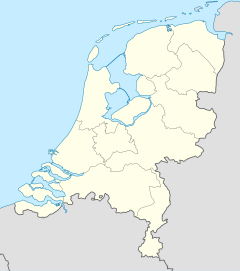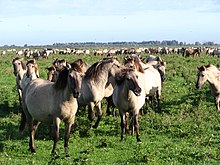Nieuw Land National Park
| Nieuw Land National Park | ||
|---|---|---|
|
|
||
| Location: | Flevoland , Netherlands | |
| Next city: | Almere | |
| Surface: | approx. 28,900 ha | |
| Founding: | 2018 | |
| Map with the different parts of the national park | ||
The Nieuw Land National Park is a nature reserve in the Dutch province of Flevoland . The national park , officially established in 2018, is currently the youngest and twenty-first national park in the European part of the Kingdom of the Netherlands . It is also the first national park in Flevoland, which has only existed as an independent province since 1986.
geography
Nieuw Land is located in the north-west of Flevoland and about three quarters of it consists of water. Only a small part of the Flevopolders and the artificial islands of the Marker Wadden make up the mainland part of the national park. In the newly created park, the wetlands Oostvaardersplassen and Lepelaarplassen , which were already protected before the foundation, as well as the southeast and eastern parts of the Markermeer are combined. Overall, this results in a size of around 29,000 hectares.
The national park consists exclusively of areas that were created through human influence. Until the 20th century the area belonged to the sea bay called Zuiderzee , which was separated from the North Sea by dykes , whereupon an extensive inland water was created. Subsequently, large parts of the former seabed in the southeast and west were polded and drained. Some of the newly gained areas came to the province of Noord-Holland , but the majority today forms the province of Flevoland.
Future planning
For the next 20 years, the Provinciale Staten of Flevoland are planning to spend 470 million euros on the further development of the park. However, these should not be borne by the province alone, but together with the forestry administration Staatsbosbeheer , the Rijkswaterstaat transport authority , the Vereniging Natuurmonumenten and the municipalities of Lelystad and Almere . Among other things, the plan provides for better connections between the individual areas of the park as well as easier access for those seeking relaxation.
Flora and fauna
Since the national park is made up of different sub-areas, some of which have been under nature protection for several decades, the fauna of the park is correspondingly diverse.
Oostvardersplassen
The Oostvardersplassen nature development area is a wetland of international importance, in the place of which a large industrial area was originally intended to be created after the Flevopolders were drained. Since there was initially no need for this, the area was initially left to nature , which quickly conquered the area. Large grazing animals have been released there since the 1980s, which have ensured that the area, in line with the mega-herbivore theory, retains its open character and is not overly forested. In this way, a new " wilderness landscape " should emerge, which should be similar to the conditions in prehistoric Europe. The Oostvardersplassen are now known beyond the borders of the Netherlands for their large herds of largely wild tail cattle , Konik horses and red deer . They are also an important refuge for thousands of birds, including various species of ducks , geese and birds of prey . Particularly noteworthy is the return of the white-tailed eagle , which has returned to the area since 2006 and cannot be seen anywhere else in the Netherlands.
Leppelaarplassen
The Leppelaarplassen are marshland with some sections of more open water that extends along the dike to the Markermeer. Among other things, there are extensive reed fields and light forests here, which are mainly dominated by pastures . The area is also known as the “little brother of the Oostvardersplassen” because of the similar history of development, but they are much smaller and are characterized by thicker forest cover. They are particularly important as a breeding and resting place for countless birds: The most important species are the cormorant - with around 1000 breeding pairs present every year - and the spoonbill from which it is named (Dutch leppelaar ). The many small and tiny islands also offer habitats and breeding grounds for species such as the little grebe , the swirl or the bearded tit. In the forest areas, however, there are species such as great spotted woodpecker , sparrowhawk and hawk . Furthermore, a population of beavers has been established in the Leppelaarplassen since 2000 .
Markermeer and Marker Wadden
The Markermeer was created in 1976 with the construction of the Markerwaarddijk between Enkhuizen and Lelystad. As a result, the IJsselmeer was divided and natural currents and drainage possibilities disappeared, which led to the silting of the Markermeer. This layer of mud is responsible for the lake's mostly cloudy water and the disappearance of most animal and plant species. To counteract this, in 2012 the artificial island group of Marker Wadden began to be filled up with the aim of creating shallows, sandbanks, reed fields and near-natural bank areas for birds and fish. The first of these islands, with a size of around 250 hectares, was completed in 2016, and four more islands will follow by 2020 and complete the archipelago. The total cost of the project should amount to around 19 million euros.
administration
The administration of the Nieuw Land National Park is divided into several organizations, each of which is responsible for a part of the entire park. As in the past, the administration of the Oostvardersplassen remains with Staatsbosbeheer, Natuurmonumenten takes care of the Marker Wadden, while the Leppelaarplassen are the responsibility of the Het Flevolandschaft Foundation.
Web links
- Official website of the national park (Dutch)
- Collection of articles on the national park at Omroep Flevoland (Dutch)
Individual evidence
- ↑ Man-made: New Dutch National Park “Nieuw Land”. In: holland.com. December 11, 2018, accessed March 26, 2019 .
- ↑ Ben Hendriks, Ruud van Capelleveen: Zuiderzeewerken. In: absolutefacts.nl. Retrieved March 26, 2019 (Dutch).
- ↑ Groen Licht voor Nationaal Park Nieuw Land. In: omroepflevoland.nl. Omroep Flevoland, February 27, 2019, accessed March 26, 2019 (Dutch).
- ↑ Feiten en cijfers. In: staatsbosbeheer.nl. Staatsbosbeheer, accessed March 26, 2019 .
- ↑ Vogel. In: staatsbosbeheer.nl. Staatsbosbeheer, accessed March 26, 2019 (Dutch).
- ↑ Lepelaarplassen. In: synbiosys.alterra.nl. Ministerie van Landbouw, Natuur en Voedselkwaliteit, accessed on March 26, 2019 (Dutch).
- ↑ Marker Wadden (Marker Watt) - a new natural paradise. In: fahrtensegeln.de. Retrieved March 26, 2019 .
- ↑ One of the Netherlands' nieuw stukje: de Marker Wadden zijn open. In: nos.nl. Nederlandse Omroep Stichting, September 24, 2016, accessed March 26, 2019 (Dutch).
- ↑ Een nationaal park, what do we have to raise? In: omroepflevoland.nl. Omroep Flevoland, October 2, 2018, accessed March 26, 2019 (Dutch).





